What’s New in Robotics? 14.01.2022

Posted on Jan 14, 2022 10:03 AM. 7 min read time
News briefs for the week take a look at CES2022’s take on industrial robotics: farm tractors, autonomous navigation technology on water, and exosuits for on-the-job heavy lifting; then, the promise of “simplicity” in a home robot, and 80,000-pound logistics robots working distribution yards.

Industrial robotics at CES2022
Never a hotbed for industrial robotics, the Consumer Electronics Show (CES; now known as CES Tech) at the very least regularly shows off a few new additions in robotics for commerce and industry. CES2022 was no different. John Deere, Avikus (subsidiary of Hyundai Heavy Industries), and Sacros were three that unveiled their new wares before a COVID-plagued, decidedly-downsized audience.
Autonomy in a kit for tractors
Although not many farmers attend consumer-oriented CES, John Deere’s $800,000 autonomous farm tractor, the 8R, was there plowing up plenty of publicity. Capable of being operated from a cellphone, the 40,000-pound, autonomous farm tractor, when in 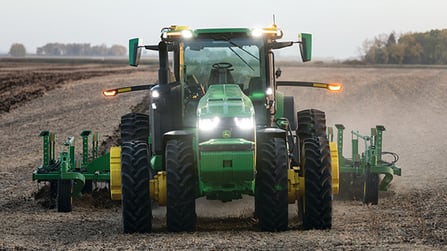 geofence mode, is accurate to within one inch. Six pairs of stereo cameras, enabling a 360-degree view, when combined with GPS guidance, help its positioning as it processes images within 100 milliseconds for determining location and obstacle detection.
geofence mode, is accurate to within one inch. Six pairs of stereo cameras, enabling a 360-degree view, when combined with GPS guidance, help its positioning as it processes images within 100 milliseconds for determining location and obstacle detection.
Interestingly for affordability and ease of installation, the John Deere innovation for tractors is actually an “autonomy kit” that can be installed in any John Deere tractor. Utilizing the installed kit, a farmer, according to Deere, “can adjust the tractor’s orders (i.e., change speed or direction), monitor its job progress and receive alerts of anomalies the software doesn’t know how to handle.” Designed to allow farmers to till their land autonomously and remotely, next up will be capabilities for planting and spraying.
Deere has two GPS processing centers and 60 land-based, geo-waypoints to ensure the critical “exactitude” necessary for proper operation of the tractor.
The rub so far: a farmer’s need for rural cellular and 5G, which for both are slow in coming to 100% coverage for farmlands.
Autonomous boats in the desert
Avikus (a subsidiary of Hyundai Heavy Industries) was in the Nevada desert showing off what it called the first-ever "self-driving" boat [no, there are others], tricked out with cameras, depth sensors and artificial intelligence systems.
Hyundai’s Do-Hyeong Lim, said: "By applying autonomous navigating technology to leisure boats, users can greatly reduce the time required for berthing and docking as well as the risk of accidents during operation."
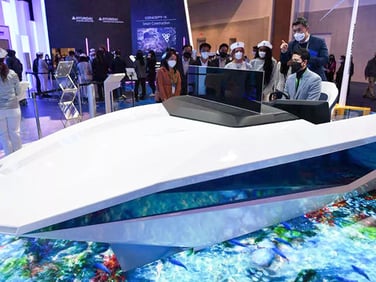 Avikus introduced a leisure boat as a future vision of the maritime mobility sector centering on autonomous vessel technology. In Korea in 2021, the craft demoed a 6-mile trip with 12 passengers on board.
Avikus introduced a leisure boat as a future vision of the maritime mobility sector centering on autonomous vessel technology. In Korea in 2021, the craft demoed a 6-mile trip with 12 passengers on board.
Angling for a more robust test, Avikus plans to demonstrate autonomous shipping technology jointly with the American Bureau of Shipping (ABS) to collaborate on real-life sea trials of autonomous ship technologies for a transoceanic voyage of a large-scale commercial vessel.
Chung Ki-sun, president and CEO of both Hyundai Heavy Industries Holdings Co. and the group’s intermediate holding company Korea Shipbuilding & Offshore Engineering Co. (KSOE), plans to present “the group’s future roadmap focusing on innovative technology for shipbuilding, offshore engineering, energy and machinery sectors.”
Exosuit to transform heavy lifting
Sarcos Technology and Robotics Corporation (spinoff from University of Utah) based in Salt Lake City), strutted out its Guardian XO exosuit for the crowd at CES2022.
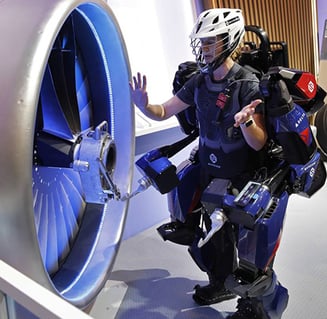 As the company’s website states: “Leveraging more than 30 years of research and development, Sarcos’ mobile robotic systems, including the Guardian S, GT, XO & XT exosuits “are designed to revolutionize the future of work wherever physically demanding work is done” with its mission’s tagline: Enabling the Industrial Workforce of the Future Through Robotics.
As the company’s website states: “Leveraging more than 30 years of research and development, Sarcos’ mobile robotic systems, including the Guardian S, GT, XO & XT exosuits “are designed to revolutionize the future of work wherever physically demanding work is done” with its mission’s tagline: Enabling the Industrial Workforce of the Future Through Robotics.
Both the Guardian XO industrial exoskeleton and the Guardian XT, which is the upper-body portion of the XO, can be used independently of one another, and will be available by the end of 2022.
The Guardian XO full-body exoskeleton, claims Sarcos, “is the world's first battery-powered industrial robot to combine human intelligence, instinct, and judgment with the power, endurance, and precision of machines.”
A field test with an electric utility construction services company, successfully conducted an “at-height tree trimming operation around active power lines,” showcased the safety aspects in reducing powerline-related fatalities and injuries.
Can simplicity in a home robot succeed?
As the Verge splashed out its headline Here’s a home robot that actually looks useful: a self-driving shelf, it certainly offers a moment of pause to consider that there’s a robot butler out there that actually fills a real need. Or does it? Maybe not.
Labrador Systems (Oak Park, CA), with $2 million in startup cash, offers two assistive home robots, the Caddie and the Retriever. Like a couple of end tables on wheels, they ferry stuff around the house. Co-founder Mike Dooley says: We started placing our pilot robots in 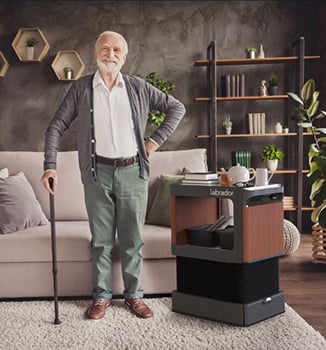 people’s homes in February 2021. After delivery and initial setup, we typically left the robots for 5 to 8 weeks for each person to use on their own. The pilot participants gave it glowing reviews (as per the video reviews on Labrador’s own website).
people’s homes in February 2021. After delivery and initial setup, we typically left the robots for 5 to 8 weeks for each person to use on their own. The pilot participants gave it glowing reviews (as per the video reviews on Labrador’s own website).
Caddie and Retriever have been household helpers for less than a year, so maybe it’s too soon to tell how helpful they really are. One thing is for sure, they are definitely simple. Call them and they come, with all sorts of stuff loaded on them, which begs the question: how does stuff get on their tabletops? There’s no “go fetch” for the blood pressure cuff you left in the kitchen. A nicely arranged meal rolling up to your La-Z-Boy still had to be nicely arranged by someone before arriving.
In short, simplicity only goes so far. Don’t expect a Manners the butler to help out. All of which may be just fine for those in need of minimal assistance. And for tens of thousands of people in the market for just a little bit of help, minimal is good; for those with greater-then-minimal needs, Caddie and Retriever may need a dose or two of functionality of an Amazon Astro, or a even Temi. At least, Labrador’s home bots carry stuff, lots of stuff, which is what the Verge says is their major selling point.
But is that enough? Watch the video, and you be the judge.
Supply-chain helper: 80,000-pound logistics robot
Outrider (Golden, CO) snapped up a $53 million investment to use massive robot truck cabs to unscramble and untangle one of supply chain’s naggingly expensive problems: the loading docks at warehouses and distribution centers.
Basically, Outrider’s autonomous operations tech consists of trailer hitching for yard tractors in order to automate distribution yards for large, logistics-dependent enterprises.
 Andrew Smith, the CEO and founder of Outrider, says his company is all about reinventing the link between the warehouse door and over-the-road transportation, all while creating efficiency for drivers on the road.
Andrew Smith, the CEO and founder of Outrider, says his company is all about reinventing the link between the warehouse door and over-the-road transportation, all while creating efficiency for drivers on the road.
“Distribution yards have a high concentration of repetitive hitching due to constant re-positioning of trailers,” reports Trailer-Body Builders. Outrider’s yard trucks hitch and unhitch from trailers reliably and consistently to move them to and from parking spots and dock doors.
In a nutshell, about Outrider’s tech, says Smith: "What we have is a fully-autonomous system that, with a click of a button…can move 40,000-pound containers effortlessly with autonomous, zero-emission [yard] trucks that are robotically connected to and from these trailers, moving between parking spots and loading bays and being positioned for those over-the-road trucks to pick them up."
Using advanced perception, motion planning, proprietary control algorithms, and sensors to confirm a successful connection, Outrider’s technology—with millimeter accuracy—enables its autonomous yard trucks to “optimally align in front of semi-trailers, back under the trailer, and attach the fifth wheel (the connection point of the truck) to the kingpin (the connection point on the trailer).
With more than 10 billion tons of freight moving across the U.S. annually, with most it passing through distribution yards, Outrider’s market potential is massive.

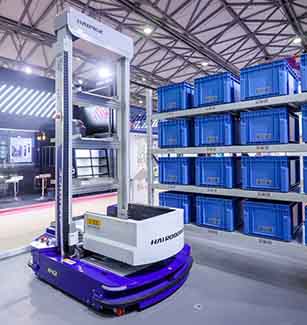
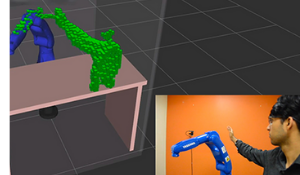

Leave a comment